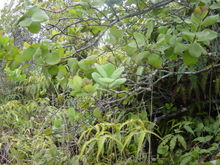- Santalum
-
Santalum 
The branches of a young Santalum paniculatum on the island of Hawaiʻi. Scientific classification Kingdom: Plantae (unranked): Angiosperms (unranked): Eudicots (unranked): Core eudicots Order: Santalales Family: Santalaceae Genus: Santalum
L.Species See text
Synonyms - Eucarya T.Mitch.
- Fusanus L.
Santalum is a genus of woody flowering plants, the best known and commercially valuable of which is the Indian Sandalwood tree, S. album. Members of the genus are trees or shrubs. Most are root parasites which photosynthesize their own food but tap the roots of other species for water and inorganic nutrients. Several species, most notably S. album, produce highly aromatic wood, used for scents and perfumes and for herbal medicine. There are approximately 25 species, ranging across the Indomalaya, Australasia, and Oceania ecozones, from India through Malesia to the Pacific Islands, as far as Hawaiʻi and the Juan Fernández Islands off the coast of South America.
Indian Sandalwood (S. album) is found in the tropical dry deciduous forests of India, the Lesser Sunda Islands of Indonesia, and Arnhem Land of northern Australia. It is the only species found on the Asian mainland, and may have been introduced to India from the Lesser Sundas centuries ago. Indian Sandalwood has been stripped from most of India's forests, and is now rare in the wild. Five species, including S. album, are native to Australia. S. acuminatum, known as the sweet quandong or native peach, produces a shiny bright red fruit used increasingly in Australia for jams, jellies, chutneys and in pies. Four species, commonly called ʻiliahi, are endemic to Hawaiʻi. S. fernandezianum, endemic to the Juan Fernández Islands off the coast of Chile, was overexploited for its aromatic wood, and may now be extinct.
Santalum species are used as food plants by the larvae of some Lepidoptera species including Endoclita malabaricus.
Contents
Nomenclature and taxonomy
Cultivation
There are numerous initial challenges to cultivating Santalum, not only due to its germination and growth needs, but also the amount of growing time required for the tree to properly mature. Germination of Santalum seeds is not completely understood. Seeds cannot be effectively stored, and must be planted upon harvesting them from a fruiting tree. Even in doing this, the seeds may not germinate. As such, growing saplings can be quite labour intensive.
Furthermore, although Santalum trees photosynthesizes on their own, the trees are semi-parasitic, with roots that seek out and tap the root systems of surrounding trees for water and nutrients. As such each sapling are usually grown together next to four to five host trees. Pruning of host trees are also needed at times since Santalum trees require much sunlight for growth.
To produce commercially valuable sandalwood with high levels of fragrance oils, the trees have to be at least 40 years of age but 80 or above is preferred. As such, those who begin cultivation of Santalum will not live to reap the rewards of their work. However, inferior sandalwood that has been cut or toppled at 30 years old can still fetch a decent price due to the demand for real sandalwood.
Beyond these initial difficulties, growing sandalwood-producing Santalum is not difficult since it becomes more resistant to environmental stresses, pest, and disease as it matures.
Species
- S. acuminatum A.DC. — Desert Quandong, Sweet Quandong, Native Peach (Australia)
- S. album L. — Indian Sandalwood, White Sandalwood, Chandana (India, Indonesia, northern Australia)
- S. austrocaledonicum Vieill. (New Caledonia, Vanuatu)[1]
- S. ellipticum Gaudich. — ʻIliahialoʻe, Coast Sandalwood (Hawaiʻi)[2]
- S. fernandezianum Phil. (Juan Fernández Islands)
- S. freycinetianum Gaudich. — ʻIliahi (Hawaiʻi)[3][4]
- S. haleakalae Hillebr. — ʻIliahi (Hawaiʻi)
- S. lanceolatum R.Br. — Northern Sandalwood (Australia)
- S. macgregorii F.Muell (Papua New Guinea, Indonesia)
- S. murrayanum C.A.Gardner — Bitter Quandong (Australia)
- S. obtusifolium (Australia)
- S. paniculatum Hook. & Arn. — ʻIliahi (Hawaiʻi)
- S. salicifolium — Willowleaf Sandalwood
- S. spicatum (R.Br.) A.DC. — Australian sandalwood (Australia)
- S. yasi Seem. - Yasi (Fiji, Niue) Tonga- Ahi [5]
References
- ^ "Santalum austrocaledonicum Vieill.". Germplasm Resources Information Network. United States Department of Agriculture. 2006-05-12. http://www.ars-grin.gov/cgi-bin/npgs/html/taxon.pl?450430. Retrieved 2009-04-05.
- ^ Little Jr., Elbert L.; Roger G. Skolmen (1989) (PDF). ʻIliahi-a-lo e, coast sandalwood. United States Forest Service. http://www.ctahr.hawaii.edu/forestry/data/CommonTreesHI/CFT_Santalum_ellipticum.pdf.
- ^ Little Jr., Elbert L.; Roger G. Skolmen (1989) (PDF). ʻIliahi, Freycinet sandalwood. United States Forest Service. http://www.ctahr.hawaii.edu/forestry/data/CommonTreesHI/CFT_Santalum_freycinetianum.pdf.
- ^ Allen, James A. (2003-01-01). "Santalum freycinetianum Gaudich." (PDF). Tropical Tree Seed Manual. Reforestation, Nurseries & Genetics Resources. http://www.rngr.net/Publications/ttsm/Folder.2003-07-11.4726/PDF.2004-03-16.2407/file. Retrieved 2009-03-01.[dead link]
- ^ "Santalum yasi Seem.". Germplasm Resources Information Network. United States Department of Agriculture. 1999-08-19. http://www.ars-grin.gov/cgi-bin/npgs/html/taxon.pl?450430. Retrieved 2009-04-05.
- "Santalum L.". Australian Plant Name Index (APNI), IBIS database. Centre for Plant Biodiversity Research, Australian Government. http://www.anbg.gov.au/cgi-bin/apni?taxon_id=6830.
- "Santalum L.". FloraBase. Department of Environment and Conservation, Government of Western Australia. http://florabase.dec.wa.gov.au/browse/profile/21329.
External links
- Australian Quandong Industry Association
- Australian Plants online: Santalum
- Hawaiian Native Plants: Santalum
- IUCN threatened species: Santalum fernandezianum
- Merlin, Mark D.; Lex A.J. Thomson; Craig R. Elevitch (April 2006) (PDF). Santalum ellipticum, S. freycinetianum, S. haleakalae, and S. paniculatum (Hawaiian sandalwood). The Traditional Tree Initiative. http://www.agroforestry.net/tti/Santalum-Haw-sandalwood.pdf.
- "ʻIliahi". Native Hawaiian Plants. Kapiʻolani Community College. http://old.kcc.hawaii.edu/campus/tour/plants/piliahi.htm.
- Thomson, Lex A. J. (April 2006) (PDF). Santalum austrocaledonicum and S. yasi (sandalwood). The Traditional Tree Initiative. http://www.agroforestry.net/tti/Santalum-a-y-sandalwood.pdf.
Categories:
Wikimedia Foundation. 2010.
